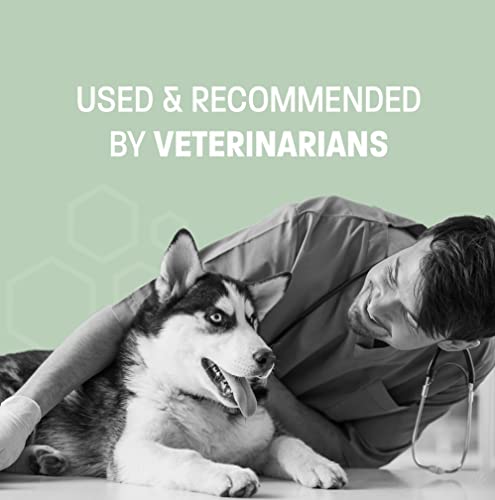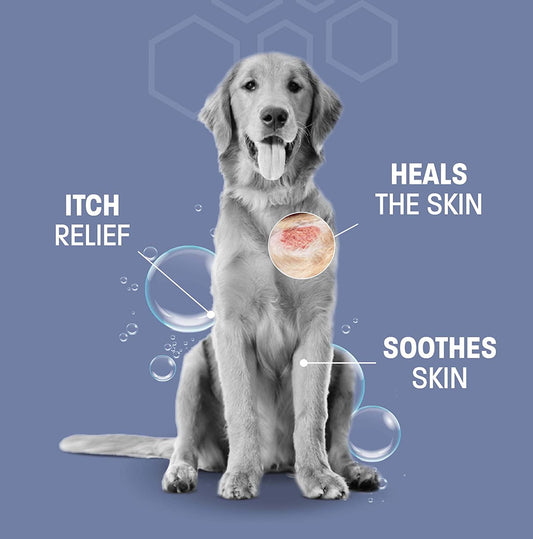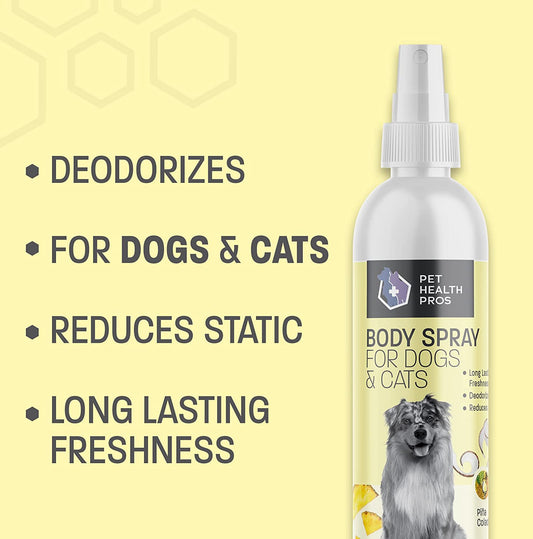When your beloved canine companion is afflicted with something unfamiliar, it's crucial to seek reliable information. Pet Health Pros demystifies ringworm in dogs, guiding you through its symptoms, causes, and treatments. Discover how our range of medicated products can be an effective part of the solution.
Ringworm, also known as dermatophytosis, is a fungal infection. It commonly affects dogs and is caused by different fungi species. These include Microsporum canis, Trichophyton mentagrophytes, and Microsporum gypseum. This is a contagious condition which can spread from infected animals or contaminated objects.
Ringworm in dogs appears as circular patches of hair loss. It often causes redness, scaling, and crusting. The affected areas may become itchy and inflamed. Commonly, ringworm is found on the head, ears, tail base, and paws - areas with higher humidity levels.
To treat it, a combination therapy is often recommended. This includes antifungal medications, such as ketoconazole or itraconazole. These stop fungi growth and spread. Also, topical treatments with antiseptic solutions containing chlorhexidine can be applied. Regular baths with an antifungal shampoo can also help.
Lastly, environmental decontamination is important. Clean the dog's living space, including bedding materials and grooming tools. Vacuuming carpets and upholstery regularly eliminates fungal spores.
What is ringworm in dogs?
To understand ringworm in dogs, tackle its causes, symptoms, and treatments head-on. Discover what triggers this common fungal infection and the signs that manifest in canines. Uncover how ringworm can spread between dogs and humans. Find solutions using antiseptic, antibacterial, and antifungal treatments like ketoconazole and chlorhexidine.
Causes of ringworm in dogs
Ringworm in dogs is caused by dermatophytes - a group of fungi. These microbes love warm and humid areas, which makes dogs vulnerable to infection. Sharing brushes, bedding or coming into contact with sick animals can spread ringworm. Puppies and dogs with feeble immune systems are more likely to contract it. Breeds with long fur or skin folds are at higher risk due to the moisture stuck in their fur.
To stop ringworm in dogs, maintain good hygiene. Bathe and groom regularly. Disinfect your pet's living area and avoid close contact with infected animals.
Pro Tip: If your pup gets ringworm, don't worry! Treatment needs to be consistent. Follow the vet's advice and give medication as prescribed. It could take several weeks for your dog to heal from this tenacious fungal infection.
Symptoms of ringworm in dogs
Ringworm in dogs is a fungal infection that can have varied symptoms. These can be mild to severe and depend on the pup and the stage of infection.
Symptoms may include:
- Circular patches of hair loss, which can be red, inflamed, and itchy/painful for the dog.
- Scaly/crusty skin around the affected areas, which can look rough and dry, and cause itching/discomfort.
- Small white/yellow bumps/pustules, which may ooze or crust over.
These signs aren't just exclusive to ringworm, as they could also be signs of other skin conditions in dogs. If you think your pooch may have ringworm, see a vet for an accurate diagnosis.
How ringworm spreads among dogs and humans
Ringworm is a contagious fungal infection that both dogs and humans can get. It spreads by contact with an infected animal, or through items like bedding, brushes, and furniture. The fungus can live on surfaces for months, so it's easy to transmit.
The ringworm fungus has tiny spores that can easily float in the air. Dogs usually get ringworm from other animals, like cats, rodents, or other dogs. Humans can be infected by contact with an infected dog, or from contaminated objects.
To avoid spreading ringworm, clean and disinfect your pet's belongings often. Keeping your dog's skin clean and dry can stop the fungus from growing.
If you think your dog has ringworm or if you've been in contact with an infected animal, see a doctor right away. Treatment usually includes antifungal medications and cleaning the living space to get rid of any spores.
Diagnosing ringworm in dogs
To diagnose ringworm in dogs, you need to be equipped with the right tools. Common diagnostic methods and the importance of early detection play a crucial role in identifying this fungal infection. Understanding these sub-sections will help you take effective measures to treat your furry friend.
Common diagnostic methods
To diagnose ringworm in dogs, several methods are used:
- A Wood's lamp examination involves using a special ultraviolet light to find fluorescent substances on the dog's skin.
- A fungal culture test takes samples from the affected areas and grows them in a lab to find the strain of fungus.
- Looking at skin scrapings under a microscope can reveal the presence of ringworm spores.
- A skin biopsy can be done too. This involves removing and examining a small piece of affected skin under a microscope. That way, a more detailed analysis is possible and it can help determine the severity.
Ringworm is treatable, but misdiagnosis can cause a dog to suffer for longer. One dog owner noticed circular patches on their pet's skin and suspected ringworm. After seeing a vet, it was confirmed and treatment was started. The condition improved quickly. This shows the importance of timely diagnosis and how vital common diagnostic methods are for proper care.
Importance of early detection
Early detection of ringworm in dogs is important for their health. Identifying this fungal infection can stop it from spreading to other animals and humans nearby. Timely treatment and quicker healing will reduce discomfort. Ringworm is very contagious, so quick action is necessary to avoid an outbreak.
Examine your dog's skin and coat for any signs, such as circular lesions or bald patches. Being proactive will ensure a healthy environment for your pet and yourself.
When looking out for ringworm, stay alert. Besides physical symptoms, observe behavioral cues too. For example, look out for excessive scratching or licking. If you notice any changes in your dog's behavior or appearance that don't go away with regular grooming and bathing, consult a vet for proper diagnosis.
Apart from visual cues, certain tests can help detect ringworm. Wood's lamp examination and fungal culture analysis conducted by dermatology professionals are two such tests. The former involves using ultraviolet light to detect fungal infections on the skin surface, while the latter involves obtaining samples from affected areas and cultivating them in a lab for accurate identification.
Here's a pro tip: In addition to monitoring at home, maintain hygiene practices to reduce the risk of ringworm transmission. Disinfect your pet's living areas and wash bedding with hot water to prevent the spread of this fungal infection.
Treating ringworm in dogs
To effectively treat ringworm in dogs, arm yourself with antifungal medications for ringworm, topical treatments for ringworm, and bathing and grooming practices for prevention. Discover how these solutions can help eliminate the fungal infection and relieve your furry friend's discomfort
Antifungal medications for ringworm
Antifungal meds are key to treating ringworm in dogs. They help get rid of the pesky and uncomfortable symptoms.
- Topical antifungal creams - Apply these creams to the dog's affected skin areas. They stop the ringworm fungus from growing and spreading, giving relief and faster healing.
- Oral antifungal meds - Use these meds when topical treatments don't work. The dog takes them orally to fight the infection from within.
- Medicated shampoos - These shampoos with antifungal ingredients can help control ringworm. Use them regularly to reduce fungal spores and prevent reinfection.
Vet supervision is essential when taking antifungal meds. Dosing and duration depend on the infection's severity and the dog's unique factors.
Pet owners must follow their vet's instructions to get the best results. Skipping doses or stopping treatment early can cause incomplete fungus removal and a relapse.
Help your furry friend fight ringworm! Talk to your vet and find the right antifungal meds.
Managing ringworm protects your dog and stops it from spreading to others. It's a must for a safe, healthy home.
Topical treatments for ringworm
For treating ringworm in dogs, antifungal creams with ingredients such as miconazole or clotrimazole can be applied topically. Medicated shampoos with ingredients like ketoconazole or chlorhexidine can also be used.
Lime sulfur is an effective treatment and can be applied as a dip or spray. Antifungal sprays with ingredients such as terbinafine or clotrimazole can be sprayed onto the dog's skin.
It's important to consult with a vet before starting any topical treatment. Consistent application of treatments is essential for effective results. Follow the vet's instructions regarding dosage, frequency, and duration of treatment for maximum effectiveness.
According to the American Kennel Club, ringworm is one of the most common contagious skin diseases affecting dogs worldwide.
Bathing and grooming practices for ringworm prevention
Bathing and grooming are essential to prevent ringworm in dogs. Here are some helpful tips:
- Bathing: Give your pup frequent baths with a medicated shampoo. Make sure it's for treating ringworm.
- Drying: Thoroughly dry your pet after each bath. Moisture can encourage the growth of ringworm fungus, so keep them dry.
- Brushing: Regularly brush their fur. This will remove any loose hairs and dead skin cells that could carry ringworm spores. Clean the brush after each use.
- Isolation: Isolate an infected animal until they're fully recovered. This will stop cross-infection.
- Hygiene: Give your dog clean bedding and toys. And regularly clean their living area.
Early detection and treatment are important for managing ringworm. If you think your pet has been exposed, consult your vet for diagnosis and treatment.
Pro Tip: Always talk to your vet before treating or adopting new bathing and grooming practices.
Using antiseptic and antibacterial products for ringworm prevention
To effectively prevent ringworm in dogs, incorporate antiseptic and antibacterial products into your routine. Prioritize cleanliness and hygiene to combat the spread of this fungal infection. Discover the recommended antiseptic and antibacterial products that can be utilized as part of the treatment plan.
Importance of cleanliness and hygiene
Maintaining cleanliness and hygiene is very important. Good habits like regular handwashing, proper waste disposal, and cleaning personal items can keep us safe from germs and viruses.
For communal spaces and public restrooms, it's key to disinfect them often with the right products.
Personal hygiene also needs to be taken into account. Antiseptic and antibacterial products are great for another layer of protection. They have ingredients that kill germs on the skin. This is especially useful for preventing skin conditions such as ringworm.
Ringworm is caused by a fungus, not a worm. It can be passed on through contact or shared objects. Antiseptic cleansers and sanitizers can help get rid of the fungus and reduce the spread of infection.
Recommended antiseptic and antibacterial products
Antiseptic and antibacterial products are a must for preventing ringworm infections. Use these recommended products to keep it away:
- Betadine Solution: This antiseptic contains povidone-iodine, which kills the fungus causing ringworm.
- Clotrimazole Cream: This over-the-counter med has an antifungal agent to stop the growth of the infection.
- Tea Tree Oil: Its natural antifungal properties make it great for fighting ringworm. Dilute before applying.
- Lamisil Spray: This spray contains terbinafine hydrochloride, which quickly treats and prevents ringworm.
- Hibiclens Antiseptic Wash: This antimicrobial cleanser helps reduce infection transmission risk.
Make sure to include these products in your daily hygiene routine to avoid ringworm. Follow the manufacturer's instructions and see a healthcare professional if symptoms persist or worsen.
Protect yourself against ringworm! Incorporate these powerful antiseptic and antibacterial products into your daily routine. Your peace of mind is worth it!
Ketoconazole and chlorhexidine for ringworm treatment
To effectively treat ringworm, consider utilizing ketoconazole and chlorhexidine. Discover the benefits and risks of using chlorhexidine and learn how ketoconazole combats ringworm. By understanding these sub-sections, you can make informed decisions about the most suitable antiseptic, antibacterial, and antifungal treatments for your dog's ringworm condition.
How ketoconazole works against ringworm
Ketoconazole is an antifungal medication that has been proven to help with ringworm. It works by inhibiting the growth of fungi that cause the infection. It specifically targets their cell membranes, disrupting them and leading to their demise.
It also offers anti-inflammatory effects. This helps alleviate the symptoms of ringworm, such as itching and redness. It reduces inflammation in the affected area and helps the healing process.
Using ketoconazole correctly is important for successful treatment. Follow your healthcare professional's instructions to ensure optimal results. However, this medication may not be suitable for everyone. Speak to a healthcare professional before using.
One person found relief after using ketoconazole for a few days. The itching stopped and the redness faded. Over several weeks, the ringworm was gone. This shows how effective ketoconazole can be in treating this fungal infection.
Benefits and risks of using chlorhexidine for ringworm
Chlorhexidine offers many advantages for treating ringworm. Firstly, it has broad-spectrum antimicrobial properties which effectively fight the fungal infection. Moreover, it is low in cytotoxicity, so it is safe for use on various skin types. Research has also demonstrated that chlorhexidine can reduce the itchiness and inflammation related to ringworm, providing relief for patients.
Nevertheless, there are potential risks when using chlorhexidine for ringworm. In uncommon cases, people may develop contact dermatitis or allergies to the solution. Thus, it is important to do a patch test before applying chlorhexidine extensively, to guarantee compatibility and lower the risk of adverse effects.
Furthermore, chlorhexidine can bind with hair and skin proteins, forming a protective barrier against further microbial growth. This characteristic increases its efficacy in preventing reinfection and recurrence of ringworm.
Preventing ringworm in dogs
To minimize the risk of ringworm infection in dogs, implement these helpful tips and maintain clean and sanitized living environments. By following these measures, you can create a healthier environment for your furry friend. Curbing the spread of ringworm is crucial, and these strategies can aid in prevention.
Tips for minimizing the risk of ringworm infection
To protect dogs from ringworm infection, keep these tips in mind! These can help stop the spread of ringworm and keep your pup safe from this common fungal infection.
- Tidy and disinfect your pup's living area. Bed, toys, and any other objects they touch should be kept clean. Ringworm spores can live on surfaces for long periods, so it's important to keep their environment clean.
- Keep your dog's fur dry and clean. Moisture favors ringworm, so dry your dog after bathing or swimming. Grooming can also help remove dirt and debris that could hide fungal spores.
- Don't get too close to infected animals. Ringworm is highly contagious and can be passed from one animal to another. If you know of a dog with ringworm, keep your pets apart until the infection has gone.
- Pay attention to hygiene. Ringworm can transfer from animals to humans. Wash your hands after handling an infected animal. Avoid touching or scratching any affected areas on your pet - this increases the risk of transmission.
Remember, prevention is better than cure when it comes to ringworm in dogs. By taking steps to reduce the risk of infection, you can help keep your dog in good health.
Cleanliness is key. Keeping their living area clean, their coat dry, avoiding infected animals, and practicing good hygiene can reduce the risk of ringworm infection.
Be vigilant and take precautions to ensure the health of your pup!
Keeping living environments clean and sanitized
To avoid ringworm in dogs, keep their living area clean and sanitized! Clean and disinfect bedding with pet-safe cleaners, vacuum rugs and upholstery on a regular basis. Wash toys, collars, and leashes with hot water and soap. Additionally, disinfect floors, walls, and surfaces with a vet-recommended cleaner.
Remember, ringworm spores can live for a long time. So, consistent hygiene is key to keep your pup safe. I learned this through a case where a family with multiple dogs had recurring ringworm infections. After deep investigation, we found out that their living environment wasn't cleaned properly. Once they implemented proper cleaning protocols, their dogs finally recovered and stayed ringworm-free. This emphasizes the importance of a clean and sanitized living space for preventing ringworm in dogs.
Conclusion
Ringworm doesn't have to be daunting. With knowledge and the right products from Pet Health Pros, you can confidently address issues like this and ensure your pet's optimal health.
Ringworm, a common fungal infection in dogs, can be treated with antiseptic and antifungal medications. Ketoconazole and chlorhexidine are usually prescribed. These medications work by killing the fungi or stopping their growth. Always follow the dosage instructions from your vet.
Regular cleaning of the infected areas is essential. Keeping them clean and dry stops the infection from spreading. Medicated shampoos and wipes can help disinfect and heal faster.
Good hygiene practices are important. Wash hands after handling an infected dog, or anything that may have come into contact with the fungus. Also, clean your dog's bedding, toys, and grooming tools regularly to stop reinfection.
To help your dog recover quickly, isolate them from other pets until treatment is done. This stops the spread of ringworm to other animals in your home or community. Disinfect common areas such as floors, carpets, and furniture with antifungal agents to remove any spores.
Frequently Asked Questions
FAQs about Understanding Ringworm in Dogs: Causes, Symptoms, and Treatments
1. What causes ringworm in dogs?
Ringworm in dogs is caused by a fungal infection. The most common culprit is a fungus called Microsporum canis, although other fungi can also cause the infection.
2. What are the symptoms of ringworm in dogs?
The symptoms of ringworm in dogs can vary, but common signs include circular patches of hair loss, redness, scaling, and itching. Some dogs may also develop crusty lesions or have a dull and brittle coat.
3. How is ringworm in dogs diagnosed?
A veterinarian can diagnose ringworm in dogs through various methods, including a fungal culture, Wood's lamp examination, or microscopic examination of skin samples. These tests help determine the specific fungus causing the infection.
4. What are the treatments for ringworm in dogs?
Treatments for ringworm in dogs typically involve a combination of antifungal medications and topical treatments. Antifungal medications like ketoconazole may be prescribed, along with medicated shampoos or creams containing antiseptic or antibacterial agents like chlorhexidine.
5. Can ringworm in dogs be prevented?
Although ringworm in dogs is highly contagious, it can be prevented through proper hygiene. Regularly cleaning and disinfecting bedding, toys, and grooming tools can help reduce the risk of infection. Additionally, avoiding contact with infected animals and maintaining a healthy immune system can also lower the chances of contracting ringworm.
6. How long does it take for ringworm in dogs to clear up?
The duration of treatment for ringworm in dogs can vary depending on the severity of the infection. Mild cases may clear up within a few weeks, while more severe or recurrent cases may require several months of treatment. It is important to follow the veterinarian's instructions and complete the full course of treatment to ensure complete eradication of the infection.








